
www.CTiIndustries.com/Ziploc 1-888-723-5198 2
Cooking, Thawing and Reheating - Simmering in a
Ziploc
®
Vacuum Sealer Bag helps food retain it’s flavor
and it helps with the clean up as well. No dirty sauce-
pans… When reheating foods in the microwave using your
Ziploc
®
Vacuum Sealer Bags, always puncture open the
bag to allow hot air to escape. You can also reheat foods
in Ziploc
®
Vacuum Sealer Bags by placing them in water
at a low simmer below 170
o
F (75
o
C).
IMPORTANT: Always thaw foods in either refrigerator
or microwave - do not thaw perishable foods at room
temperature.
Preparation Hints for Meat and Fish:
Try pre-freezing meats and fish for 1-2 hours before vacu-
um packaging. This helps retain the juice and shape, and
provides for a better seal.
If you can’t, place a folded paper towel between the food
and top of the bag, but below seal area. Leave paper
towel in bag to absorb excess moisture and juices during
vacuum packaging process.
Preparation Hints for Cheeses:
Buy fresh and keep fresh, that’s our motto… vacuum
package cheese after each use. If you make your bag just
a little longer than needed, you can re-seal the bag after
each use.
IMPORTANT: Due to the risk of anaerobic bacteria,
soft cheeses should never be vacuumed packaged.
Preparation Guidelines for Vegetables:
Mom always said “eat your vegetables..”, we say blanch
them… Blanching is a process that should be done
before vacuum packaging. This process stops the enzyme
action that could lead to loss of flavor, color and texture.
To blanch vegetables, place them in Simmering water or
in a microwave until they are cooked, but still crisp.
Blanching times can range from 1 to 2 minutes for leafy
greens and peas; 3 to 4 minutes for snap peas, sliced
zucchini or broccoli; give your carrots about 5 minutes;
and 7 to 11 minutes for corn on the cob. After blanching,
immerse vegetables in cold water to stop the cooking
process.
NOTE: All vegetables (including broccoli, brussels
sprouts, cabbage, cauliflower, kale, turnips etc.) natu-
rally emit gases, during storage. Therefore, after
blanching, it’s best if they’re stored in the freezer.
Vacuum Sealing Guidelines
IMPORTANT: Vacuum packaging is NOT a substitute
for refrigeration or freezing. Any perishable foods
that require refrigeration must still be refrigerated or
frozen after vacuum packaging.
For best result in extending the life of foods, it is im-
portant to vacuum package foods that are fresh. Once
food has begun to deteriorate, vacuum packaging may
only slow the deterioration process. Vacuum sealing
cannot prevent the growth of mold. Other disease
causing microorganisms can still grow in low oxygen
environments and may require further measures to be
eliminated.
Yeast - The development of yeast can be slowed by
refrigeration and completely stopped by freezing food at
0oF(-18oC). Yeast causes fermentation, which will give
food an identifiable smell.
Bacteria - Bacteria can grow rapidly in the “Danger
Zone”, the temperatures between 40
o
F and 140
o
F.
Pathogenic bacteria cause illness and do not generally
affect the taste, smell or appearance of food. Although it
is extremely rare, it can be very dangerous.
There are basic rules to follow when handling food.
These are COOK, SEPARATE, CLEAN and CHILL.
Cook– It is crucial to cook food to a safe internal
temperature to destroy bacteria that is present. Bacteria
is not just a surface condition, it can also be found deep
within the mixture of meats and other foods.
Separate - Foods that will be eaten uncooked and foods
that will be cooked before eating MUST ALWAYS be
kept separate. Cross contamination can occur when raw
foods (such as meats or eggs) come in contact with
foods that will be eaten before or after cooking. This has
been known to be a major source of food poisoning.
Always use your Ziploc
®
Vacuum Sealer Bags to ensure
that juices won’t drip onto fresh produce or other foods.
Clean– Wash hands and work surfaces frequently when
cooking. Washing with soap and water for at least 15
seconds, then dry with a paper towel.
Chill - Chilling food is very important. To help preserve
foods safely, do not allow food to stand at room temper-
atures for 2 hours or more, set your refrigerator to 40
o
F
(4
o
C) or colder and your freezer to 0
o
F(-17
o
C). Freezing
at 0
o
F does not kill microorganisms, but stops them from
growing. For long-term storage, always freeze perisha-
ble foods that have been vacuum packaged and keep
refrigerated after thawing.


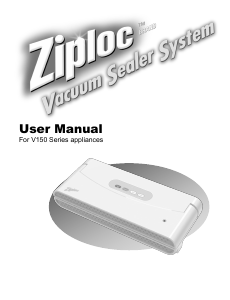

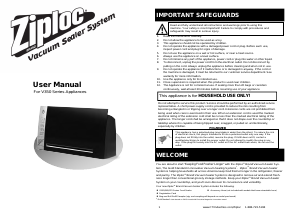
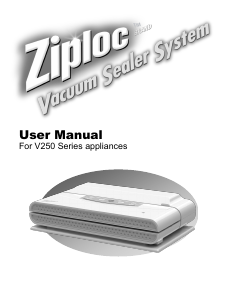

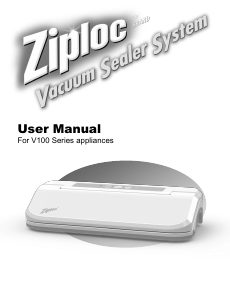
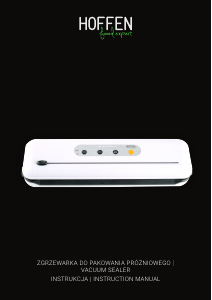
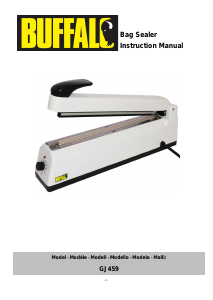

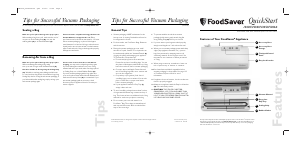
Join the conversation about this product
Here you can share what you think about the Ziploc V150 Vacuum Sealer. If you have a question, first carefully read the manual. Requesting a manual can be done by using our contact form.